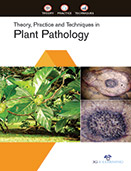Agriculture and Life Sciences

Plant pathology is concerned with keeping plants healthy by diagnosing and treating common plant diseases. Plant diseases play an important role on our daily lives. Most of plant diseases are visible and are caused by biotic and/or abiotic factors. Symptoms are usually the results of a morphological change, alteration or damage to plant tissue and/or cells due to an interference of the plant’s metabolism. All basic structures of vascular plants are subject to attack by pathogens. The failure in accurate disease diagnosis and management may lead to huge losses in plant production and related commodities, which causes nutritional food scarcity. Typically, the appearance of a biotic symptom will indicate the relatively late stage of an infection and/or colonization of a pathogen. Significant diseases of plants in agriculture are caused by diverse pathogens, including viruses, bacteria, fungi, and nematodes. Plant diseases are of paramount importance to humans because they damage plants and plant products on which humans depend for food, clothing, furniture, the environment, and in many cases housing. For millions of people all over the world who still depend on their own plant produce for survival, plant diseases can make the difference between a happy life and a life haunted by hunger or even death from starvation. For countries where food is plentiful, plant diseases are significant primarily because they cause economic losses to growers.
“Theory, Practice and Techniques in Plant Pathology” covers several aspects of plant pathology and its sub disciplines like Mycology, Plant Virology, Plant Bacteriology and Plant Nematology etc. Diagnosis, disease management, and the molecular basis of host-pathogen interactions are examined. The each chapter contains specific key notes, learning objectives, comprehensive indicative content, tables, and illustrations together with the topic areas. This book has been designed essentially for the use of students engaged in advanced undergraduate and postgraduate courses in plant pathology.